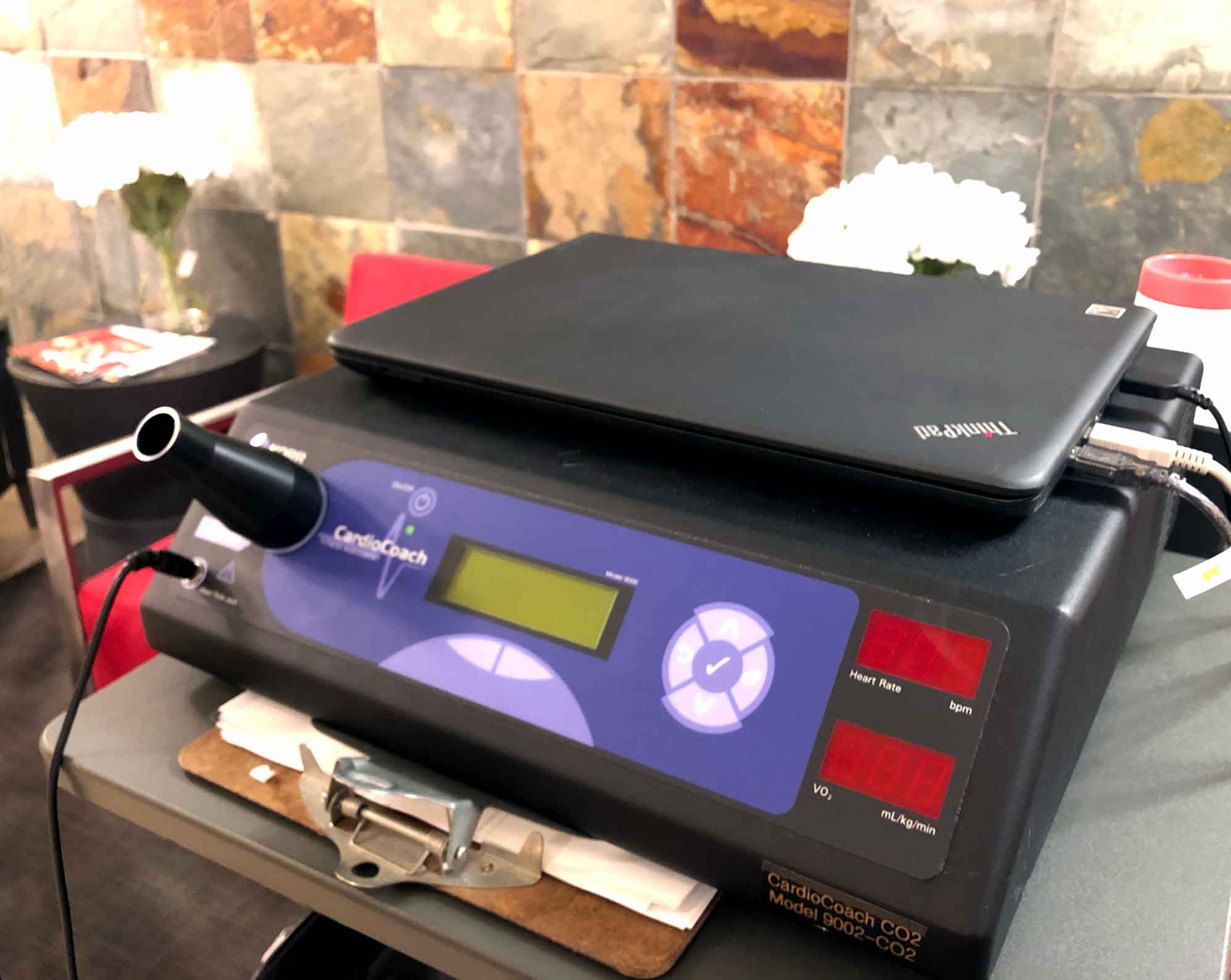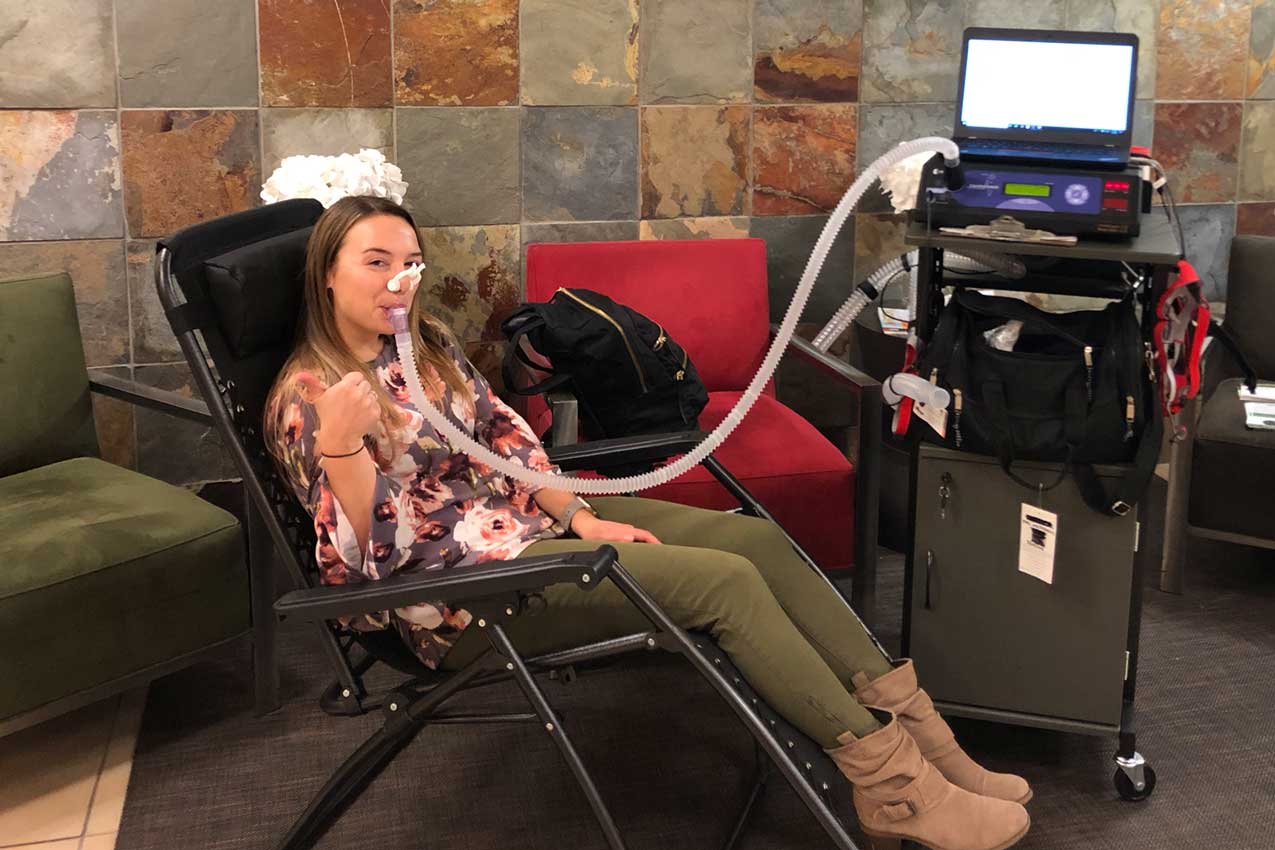A dream of mine? To be told I should eat more food – by data, no less. That dream came true during my recent resting metabolic rate test at Fitness Formula Clubs in Chicago. What’s a resting metabolic rate test, you ask? In the simplest terms, a resting metabolic rate test is a test to determine how much energy (read: calories) your body burns while at rest, in order to perform basic functions of living, by measuring your oxygen and carbon dioxide levels – and therefore, your daily caloric requirements for weight maintenance, gain or loss based on your unique metabolism. Sure, you could work with a RMR calculator (there are a couple online) to find out how many calories you should be eating – but since those aren’t based on your unique metabolism, they can be off. To get an accurate reading, it’s better to meet with a licensed registered dietitian and have an RMR test administered.

How the RMR Test Works
As opposed to an RMR calculator, the resting metabolic rate test requires the use of a machine with a tube you breathe into that will use oxygen consumption measurement to determine your caloric requirements for weight loss, gain or maintenance. Since you need to be completely at rest, you will asked to recline in a chair while you have the test done, as well as wear a nose clamp (sounds weird and scary, but basically it’s just a padded thing you put on your nose to keep your nostrils closed so that all your breathing happens in the tube).
RMR Calculator vs RMR Test: Why You Should Do an RMR Test
As I mentioned before, RMR calculators are great and all – but they’re based on a formula. An actual RMR test analyzes your breath and gives you MUCH more accurate data. For example, I use an app called MyFitnessPal (when I remember) to keep tabs on my diet and to try and reign in my occasional snacking festivals – especially in the winter! According to that app, I was supposed to eat something like 1200 calories a day. Between meals and snacks there was barely room for anything else. I was constantly going over, feeling guilty all the time. I also incorrectly accounted for my exercise – I typically try to work out at LEAST 4 times a week. They’re also fairly intense workouts. Couple that with a meager 1200 calories and you get one very tired, irritable and hangry individual.
When FFC West Loop registered dietitian Emily Marshall and I looked at an online calculator before my test, it was also pretty low – around 1325 calories a day. Post test, we found out that my actual RMR is up around 1555 calories a day – at a slightly elevated level beyond “normal”. Add in my exercise, and I should be eating something like 1900 calories – even in order to lose a pound a week!! So with no exercise, I should have been eating an additional 230 calories a day than what was predicted by the RMR calculator (which operates using an equation known as the “Mifflin St. Jeor” equation).
In the simplest terms, a resting metabolic rate test is a test to determine how much energy (read: calories) your body burns while at rest, in order to perform basic functions of living, by measuring your oxygen and carbon dioxide levels – and therefore, your daily caloric requirements for weight maintenance, gain or loss based on your unique metabolism.
Emily explained that with the equation estimation, it would have taken a fair amount of time and trial and error to figure out how much to eat for my body and goals – but with the RMR test, I have a much better starting point right off the bat. Not to mention, with the results, I can feel the effects that much faster – eating more and fueling my body properly means more energy, better ability to focus and a faster exercise recovery time. I have been feeling pretty sluggish lately and I am definitely noticing a slight change since being more mindful of eating proper snacks etc. Of course, this is my personal result based on my body – it will be different for everyone. However, there is something to be said for having a roadmap to get to one’s goals more quickly and accurately. Our bodies are like machines and are a lot more formulaic than we realize. The right combination and amount of fats, proteins and carbs can really make that much difference in how well and efficiently it functions!

Important note: I agreed to do this test in the lobby to help bring awareness to the awesome power of data and wellness, but this is not the norm. You will definitely have privacy! Unless, you know, you want to hang out and wave at people while you’re taking your test. You do you.
How to Prepare for the RMR Test
If you happened to see my post about my Vo2 Max experience a couple of months ago (which basically measures how efficiently you exercise), you’ll know that gearing up for a test like this requires some prep on the front-end. As in, the fasting kind. My recommendation is to try to schedule the test as early as possible so you don’t have to worry about depriving yourself of food or caffeine for very long! (I did mine bright-eyed and bushy-tailed at 7 AM). In order to get the most accurate results possible, you will need to make sure you
- Don’t eat or drink anything prior to your test (check with the registered dietitian for specific timeframe).
- Don’t drink caffeine before your test.
- Refrain from exercise 24 hours before your test – if your workouts are high-intensity, you may need to hold off for 48 hours. Again, check with the RD!
- Wear regular clothes (I wore my regular office clothes).
- Bring something to occupy yourself for about 25-30 minutes that you can do with one hand in case you need to hold the tube for more comfort.
Things I’d Want My Former Self to Know Before Taking an RMR Test
The test was quick and painless – albeit a little awkward, but overall very simple. Emily did a great job of explaining the process to me, what each of the pieces of equipment was for, how the machine worked, etc. Here are a couple of tips & tricks for anyone considering taking an RMR test.
- #1 most important thing – bring chap stick! If your lips get dry easily, I recommend some kind of chap stick or lip balm. If you get drooly, they will have tissues for you. The RD will explain!
- Yes, they do use all-new disposable nose clamps, mouth pieces and breathing tubes – no germs here.
- Don’t do the test with a cold – because you’re only breathing through your mouth, it can do wonky things to your head pressure – I would maybe stay away from the test if you’re experiencing a head cold.
- Breathing with the tube will be weird – kind of like a snorkel.
- Hold the tube with your hand if you find yourself wanting to bite down on the mouth piece so that your jaw doesn’t get tired! That’s why I recommend a phone or Kindle etc. that you can hold with one hand.
How to Sign Up for an RMR Test
Yes, this might sound a little more complicated than a simple online RMR calculator, but I promise the data and knowledge you will come away with will be well worth it. Now, I can use my results to figure out meal plans, and have a much better understanding of how much I should be eating for specific goals. Plus, if I ever wanted to start a race training program, kick up my weight loss a notch, etc., I would have an accurate roadmap to do it. To sign up for a test at FFC, you can visit this link or email metabolictesting@ffc.com! Questions about the specifics? You can email registered dietitian Emily Marshall at emarshall@ffc.com or visit your club’s RD.
Post written by FFC marketing manager Megan Zink.
